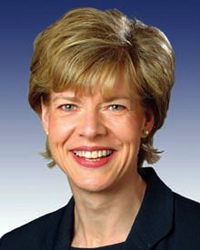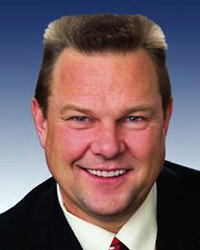Senate scorecard: Who won, and whom they owe
 |
 |
As with the presidential race, conservative outside groups who dropped the most money on heated Senate contests didn't get a great return on their investments. But that doesn't mean the new or returning senators that emerged victorious weren't also backed by big money. These groups, dominated by labor, will be asking for something in return for their support.
Virginia: Sen.-elect Tim Kaine
This race drew the attention of the biggest players in the outside spending game, who dropped more than $50 million in the race. Republican George Allen attracted the mostoutside spending — $29.6 million compared to $20.7 million for Democrat Kaine. But Kaine raised more directly for his campaign in the 2012 cycle — $17.4 millionto Allen's $12.5 million. Crossroads GPS, spent $10.6 million, and the U.S. Chamber of Commerce, which paid $4.5 million, shelled out more here than in any other congressional race. Ditto for the League of Conservation Voters, which spent more than $2 million the race in support of Kaine, and Majority PAC, which spent $6 million. Majority PAC had one of the best return on investments this election cycle among super PACs at 87.9 percent, according to Sunlight calculations.
Other non-party big spenders on behalf of Kaine or opposing Allen were the SEIU, Environment America Action Fund, AFSCME, Planned Parenthood, and the NEA, a kind of who's who of which interest groups spent big supporting Democrats in this election. Top on the list for these groups is defending Obamacare, women's access to health care, pushing for stronger enforcement of environmental laws, and fending off big cuts in entitlements as part of the negotiations about the budge impasse. Sometimes their concerns are more prosaic, however: for example, AFSCME will be watching out specifically for the federal employees who comprise a major component of Kaine's Washington, D.C.-area constitutents, trying to avoid further salary freezes or cuts in benefits.
A look at Kaine's direct contributors shows a different cast of characters. Lawyers and lobbyists from some of the nation's biggest firms gave him $1.6 million; this includes Akin Gump, McGuireWoods, Covington & Burling, Skadden Arps, and Patton Boggs, all of which have thriving lobbying practices. He also received about $1 million from the financial sector, including $30,000 from employees of Bain Capital–the very firm where Mitt Romney once worked and that President Barack Obama made a feature of campaign ads excoriating him for making money for investors while firing employees.
Wisconsin: Sen.-elect Tammy Baldwin
Wisconsin's toss-up race between Baldwin, a Democratic member of the House, and former Wisconsin Gov. Tommy Thompson was second only to Virginia's Senate contest in terms of outside spending, with $42.6 million in independent expenditures. And here, again, we see the U.S. Chamber of Commerce, Crossroads GPS, and American Crossroads topping the list of non-party outside spenders that bet on the Republican and lost. However, this time they were outspent by the outside groups that supported Baldwin. She drew $20.6 million from outside groups in support versus Thompson's $18.3 million.
Baldwin got big help from Majority PAC, which spent $4.7 million opposing Thompson; the SEIU, which helped with $1.8 million from different entities, and Women Vote!, the Super PAC affiliated with Emily's List, which spent more on her campaign than any other. Majority PAC was funded heavily by Colorado-based gay rights donor Tim Gill. Baldwin will be the first openly gay member of the U.S. Senate.
Baldwin also raised more funds directly this election cycle than Thompson did, $12.7 million versus $7.4 million. Top donors to her campaign committee include a number of liberal groups, some reflecting the outside spenders, such as Emily's List and League of Conservation Voters. She also got a boost of nearly $55,000 from J Street PAC, which advocates for a two-state solution in Israel and was founded to be a foil against hawkish groups such as AIPAC.
Ohio: Sen. Sherrod Brown
In another campaign where conservative outside spenders bet big and lost, groups such as Crossroads GPS and the U.S. Chamber of Commerce spent nearly $22 million supporting the candidacy of Ohio Treasurer Josh Mandel in this crucial swing state. Freedomworks for America, a libertarian PAC that tends to emphasize grassroots work also weighed in on behalf of the GOP challenger.
In contrast, incumbent Sherrod Brown, known as one of the Senate's most liberal members, got $13.8 million in outside support. Leading the way were Majority PAC (see also: Baldwin, above), which spent $3.2 million against Mandel; the SEIU, which spent $2.3 million; and the NEA, which spent $1 million, more on this race than any other.
Brown's top direct contributor is JStreet PAC, with more than $71,000. The Ohio campaign was a flashpoint for the Jewish community, which traditionally votes Democratic. However, some of the major donors to outside groups this election, such as Sheldon Adelson, are hawkish on Israel and tried to steer Jewish votes toward Romney and the GOP. Mandel–related by marriage to a prominent Ohio Jewish family in the development business, Forest City, was reported to have divided the family and the community. Indeed, Forest City Enterprises also figures as one of Brown's top donors. A recent lobbying report filed by the company states the company is seeking "federal funding for Forest City projects across the United States, in particular Denver, Washington, D.C., Albuquerque, Ohio, New York City and Dallas, TX."
Indiana: Sen-elect Joe Donnelly
This open seat race drew more than $30 million in outside spending, with the conservative Crossroads groups, Freedomworks, and Club for Growth spending a total of $14.7 million backing Tea Party candidate Richard Mourdock versus $10.5 million in spending favoring Donnelly, a Democratic congressman. Mourdock, who upset long ime Sen. Richard Lugar in the Republican primary, bested Donnelly in the direct fundraising race as well, raising $7.9 million in the 2012 cycle to Donnelly's $4.7 million.
But money couldn't buy Mourdock victory. He drew much negative attention in late October, when he explained his position on abortion by saying that when a woman becomes pregnant through rape "it is something God intended." The resulting firestorm boosted Donnelly's candidacy and drew more spending by benefitting the Democrat. For example, the day after Mourdock made his remark, Majority PAC spent more than $980,000 on a media buy; over all, the liberal super PAC would spend $4.3 million opposing Mourdock, more than half of that committed after Mourdock made his remarks.
Donnelly enters the Senate after serving three terms in the House, giving him time to build up a list of career top donors to his campaign fund. A member of the money-magnet House Financial Services Committee, Donnelly has raised nearly $849,000 from the financial sector over the course of his career. Labor, however, is his largest contributing sector, with $1.2 million.
Montana: Sen. Jon Tester
A total of $24.7 million was spent by outside groups on this campaign in a sparsely populated red state that elected a blue senator in 2006, Tester, who faced Republican challenger Rep. Denny Rehberg. The race was so close that the result was not announced until the day after the election.
The cast of characters was familiar: Crossroads groups and the U.S. Chamber of Commerce were among the conservative groups spending the most opposing Tester, spending a total of $12.1 million. But Democratic leaning groups nearly matched this amount with $11.9 million. Top among them: the now familiar Majority PAC, a feature in so many of the Senate wins. Tester also got help from the AFL-CIO, the League of Conservation Voters, and Planned Parenthood.
Tester is a member of the powerful Senate Appropriations and Finance Committees, and contributions to his campaign fund reflect those assignments. The financial sector has given him $1.7 million, and lawyers and lobbyists, $1.6 million. His top donors include JP Morgan & Chase, Visa Inc., and the Blackstone Group. All of these companies lobby heavily on the Dodd-Frank financial law and its implementation.
Florida: Sen. Bill Nelson
This race, pitting incumbent Nelson against Connie Mack, a Republican congressman who was attempting to recapture the seat that his father once held. It drew $21.3 million in outside spending, the great majority of it–$16.1 million–favoring Mack. American Crossroads, the U.S. Chamber of Commerce, and Freedomworks led the pack, along with Freedom PAC, a Florida focused Super PAC that spent more here than anywhere else.
In contrast, Nelson attracted $4.7 million in outside support; the biggest spender was the Majority PAC, which spent more than $958,000 opposing Mack.
Nelson had a much larger campaign warchest: $12.9 million raised over the past two years, nearly twice as much as the $6.6 million raised by Mack. Nelson serves on three committees that will be at the center of debate over the budget impasse in Congress–Budget, Finance, and Commerce. Lawyers and lobbyists have given him more than $7 million over the course of his congressional career and the financial sector, raised $4.9 million.
Massachusetts:Sen.-elect Elizabeth Warren
In a bitterly fought race that did not draw much outside spending compared to other races, incumbent Sen. Scott Brown lost his seat to populist firebrand Warren. She emerged into national attention after the 2008 financial meltdown, when she was appointed by Sen. Majority Leader Harry Reid, D-Nev., to head up congressional oversight of the bank bailout. Before that she'd made her name in academia studying bankruptcy.
In January, Warren and Brown had made a pact banning third-party advertising–not that technically they had any control over this–and groups such as the League of Conservation Voters and the labor-fueled Rethink PAC ended up spending more than $1 million apiece opposing Brown. Overall, conservative groups spent $3.3 million favoring Warren and $2.8 million backing Brown.
All of this was far overshadowed by the amount Warren raised in direct contributions–$39 million over the last two years. Popular with liberals nationwide, more than half, 58 percent, of Warren's contributions came from out of state and 44 percent came in small contributions under $200. Most of her top direct donors are ideologically charged, connected to universities, or work for law firms: Emily's List leads the way with more than $300,000; followed by individuals working for Harvard University, where she has worked as a professor, with $169,000.

